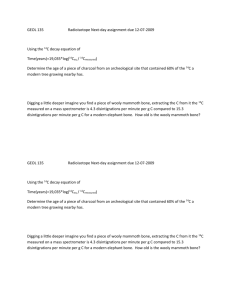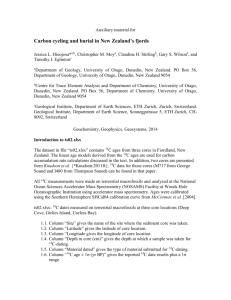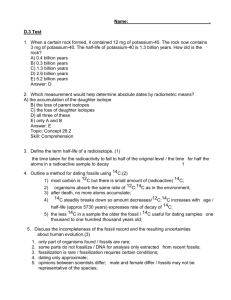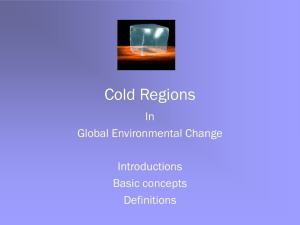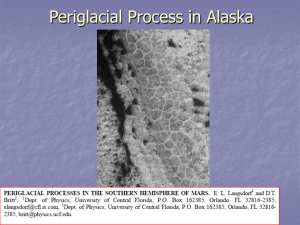gbc20356-sup-0001-supplementary
advertisement
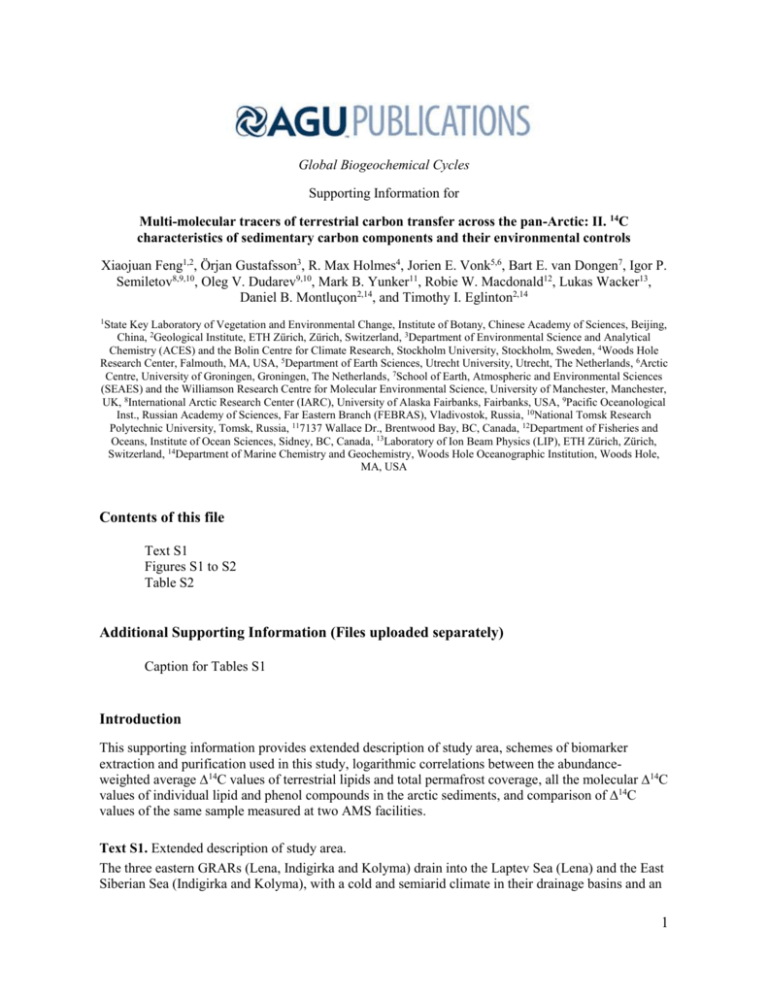
Global Biogeochemical Cycles Supporting Information for Multi-molecular tracers of terrestrial carbon transfer across the pan-Arctic: II. 14C characteristics of sedimentary carbon components and their environmental controls Xiaojuan Feng1,2, Örjan Gustafsson3, R. Max Holmes4, Jorien E. Vonk5,6, Bart E. van Dongen7, Igor P. Semiletov8,9,10, Oleg V. Dudarev9,10, Mark B. Yunker11, Robie W. Macdonald12, Lukas Wacker13, Daniel B. Montluçon2,14, and Timothy I. Eglinton2,14 1State Key Laboratory of Vegetation and Environmental Change, Institute of Botany, Chinese Academy of Sciences, Beijing, China, 2Geological Institute, ETH Zürich, Zürich, Switzerland, 3Department of Environmental Science and Analytical Chemistry (ACES) and the Bolin Centre for Climate Research, Stockholm University, Stockholm, Sweden, 4Woods Hole Research Center, Falmouth, MA, USA, 5Department of Earth Sciences, Utrecht University, Utrecht, The Netherlands, 6Arctic Centre, University of Groningen, Groningen, The Netherlands, 7School of Earth, Atmospheric and Environmental Sciences (SEAES) and the Williamson Research Centre for Molecular Environmental Science, University of Manchester, Manchester, UK, 8International Arctic Research Center (IARC), University of Alaska Fairbanks, Fairbanks, USA, 9Pacific Oceanological Inst., Russian Academy of Sciences, Far Eastern Branch (FEBRAS), Vladivostok, Russia, 10National Tomsk Research Polytechnic University, Tomsk, Russia, 117137 Wallace Dr., Brentwood Bay, BC, Canada, 12Department of Fisheries and Oceans, Institute of Ocean Sciences, Sidney, BC, Canada, 13Laboratory of Ion Beam Physics (LIP), ETH Zürich, Zürich, Switzerland, 14Department of Marine Chemistry and Geochemistry, Woods Hole Oceanographic Institution, Woods Hole, MA, USA Contents of this file Text S1 Figures S1 to S2 Table S2 Additional Supporting Information (Files uploaded separately) Caption for Tables S1 Introduction This supporting information provides extended description of study area, schemes of biomarker extraction and purification used in this study, logarithmic correlations between the abundanceweighted average ∆14C values of terrestrial lipids and total permafrost coverage, all the molecular ∆14C values of individual lipid and phenol compounds in the arctic sediments, and comparison of ∆14C values of the same sample measured at two AMS facilities. Text S1. Extended description of study area. The three eastern GRARs (Lena, Indigirka and Kolyma) drain into the Laptev Sea (Lena) and the East Siberian Sea (Indigirka and Kolyma), with a cold and semiarid climate in their drainage basins and an 1 extensive coverage (79-100%) of continuous permafrost. This contrasts with the two western GRARs (Ob’ and Yenisey) draining the west Siberian lowland into the Kara Sea, and the Kalix River that flows through sub-arctic Scandinavia into the Baltic Sea, which are all characterized by wetter climates, milder winters, and a much lower coverage of continuous permafrost (2-33%; Table 1). The GRAR drainage basins are characterized by various tundra and wetlands in the north and by forests in the south [FAO, 2001; van Dongen et al., 2008a]. The Kalix watershed mainly consists of forests (60%) and wetland (20%) [Hjort, 1971]. A more detailed description of the Eurasian arctic drainage basins is provided elsewhere [van Dongen et al., 2008a; Vonk et al., 2010; Holmes et al., 2013]. The drainage basin of Mackenzie River spans the western alpine region of the Cordillera Mountains to the Canadian Shield and includes forests, swamps, grasslands, and permafrost soils. Previous studies have established that petrogenic OC, mainly supplied by thermally immature bitumen, shales, or coals from the Devonian Canol formation, is actively cycling through the Mackenzie system [Yunker et al., 2002; Goñi et al., 2005; Drenzek et al., 2007]. The Yukon River drains northwestern Canada and central Alaska in the United States into the Bering Sea. Its drainage basin is characterized by diverse ecosystems including forests, shrublands, tundra, and extensive areas of permafrost [Brabets et al., 2000]. The Colville River, originating in the Brooks Range in northern Alaska, is much smaller than the Yukon and Mackenzie in terms of watershed area (Table 1), but is the largest North American river (both in terms of freshwater and sediment load) that exclusively drains continuous permafrost [Walker, 1998]. The Colville flows from the foothills of the Brooks Range and across the adjacent arctic coastal plain to the Beaufort Sea. Its watershed is characterized by dwarf and low shrub tundra, with mossy carpets and moist peaty soils [Walker et al., 2002]. Additional references: Brabets, T. P., B. Wang, and R. H. Meade (2000), Environmental and hydrological overview of the Yukon River Basin, Alaska and Canada, in US Geological Survey Water Resources Investigations Report 99-4204, pp. 106. FAO (2001), Global ecological zoning for the global forest resources assessment 2000, Final Report For Dep., Food and Agricul. Org., U.N., Rome. Hjort, S. (1971), Torne och Kalix älvar, del 1. Allmän beskrivning, Uppsala, Universitet, UNGI. Rapport, Uppsala. Walker, D. A., W. A. Gould, H. A. Maier, and M. K. Raynolds (2002), The Circumpolar Arctic Vegetation Map: AVHRR-derived base maps, environmental controls, and integrated mapping procedures, Intl. J. Remote Sens., 23, 4551-4570. 2 Sediment Solvent extraction (DCM:methanol, 2:1) Total lipid extract Residue Saponification & extraction at pH 7 Neutral fraction Silica gel column AgNO3impregnated silica column n-Alkanes Alkaline hydrolysis (1 M KOH, 100 °C, 3 h) Aqueous residue Residue Hydrolysis products Saponification & extraction at pH ~14 Acidification & extraction at pH 2 Acid fraction Neutral fraction CuO oxidation SPE cartridges (ENVI-18 & LC-NH2) Aqueous residue Lignin & hydroxy phenols Acidification & extraction at pH 2 Methylation Silica gel column Acid fraction AgNO3impregnated silica column Methylation Silica gel column FAMEs Hex: EtOAc (95:5) Hex: EtOAc (4:1) AgNO3impregnated silica column AgNO3impregnated silica column Hex b-FAMEs DCM EtOAc di- & triHydroxy FAMEs Hydroxy FAMEs DAMEs Figure S1. Procedures of biomarker extraction and purification used in this study. Compounds in the shaded boxes were selected for 14C analysis. DCM: dichloromethane; Hex: hexane; EtOAc: ethyl acetate; SPE: solid phase extraction; FAME: fatty acid methyl ester; DAME: diacid dimethyl ester. Refer to Materials and Methods and Feng et al. [2015] for detailed descriptions. Please note that n-alkanes and FAMEs were separated from the total lipid extracts using slightly different procedures (involving Bond-Elute column chromatography) for the Kalix and GRAR sediments (details in van Dongen et al. [2008a]). 3 Figure S2. Logarithmic correlations between the abundance-weighted average ∆14C values of terrestrial lipids and total permafrost coverage (including continuous, discontinuous, sporadic and isolated permafrost in Table 1). Plant wax lipids include C27,29,31 n-alkanes and C24,26,28 fatty acids; DAs: diacids. 4 Table S1. The ∆14C values of individual lipid and phenol compounds and their abundanceweighted averages in the arctic river sediments (‰). All values are corrected for procedural blanks with the standard errors of analytical measurement propagated. The ∆14C values of nalkanes and fatty acids (FAs) in Mackenzie and Eurasian arctic rivers are derived from Drenzek et al. [2007] and Gustafsson et al. [2011], respectively. The ∆14C values of lignin and hydroxy phenols in Eurasian arctic rivers are also found in Feng et al. [2013a]. Detailed concentration data are in Feng et al. [2015]. 5 Table S2. Comparison of ∆14C values of the same sample measured at two AMS facilities (NOSAMS and ETH Zürich). All values are corrected for procedural blanks with the standard errors of analytical measurement propagated. Sample content AMS # 80884 Ob' Syringaldehyde Acros Vanillic acid Acros Acetovanillone Sigma Vanillin Facility NOSAMS Size (μg C) Fm ∆14C (‰) 38 0.6438 ± 0.0082 -361 ± 8 43766.1.1 ETH 16 0.6643 ± 0.0246 -341 ± 25 80286 182 0.0053 ± 0.0014 -995 ± 1 45131.1.1 ETH 23 0.0386 ± 0.0102 -962 ± 10 80287 163 0.0241 ± 0.0016 -976 ± 2 47488.1.1 ETH 37 0.0260 ± 0.0061 -974 ± 6 78965 152 1.1343 ± 0.0080 126 ± 8 20 1.1503 ± 0.0316 142 ± 32 NOSAMS NOSAMS NOSAMS 45129.1.1 ETH 6

